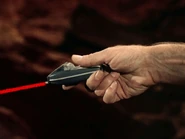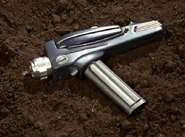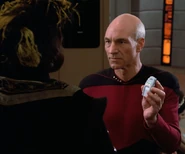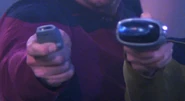m (Reverted edits by 24.228.30.196 (talk | block) to last version by Archduk3) |
m (-dup lk) Tag: sourceedit |
||
| (12 intermediate revisions by 7 users not shown) | |||
| Line 1: | Line 1: | ||
| + | {| class="wiki-sidebar" |
||
| ⚫ | |||
| + | |- |
||
| + | | colspan="2" align="center" |[[File:Phaser type-1, 2360s.jpg|250px|Type 1 phaser]] |
||
| + | <br />Type-1 phaser circa [[2367]] |
||
| + | |- |
||
| + | | class="odd" | Type: |
||
| + | | class="even" | [[Phaser]] |
||
| + | |- |
||
| + | | class="odd" | Output: |
||
| + | | class="even" | Beam |
||
| + | |- |
||
| + | | class="odd" | Manufacturer: |
||
| + | | class="even" | [[Starfleet]] |
||
| + | |- |
||
| + | | class="odd" | Era: |
||
| + | | class="even" | [[23rd century]] to [[24th century]] |
||
| + | |} |
||
| ⚫ | |||
| ⚫ | The type 1 has eight adjustable settings, ranging from stun to heat through disruption to disintegration. The [[23rd century]] type 1 in use in the [[2260s]] incorporated a small flip-up [[sight]] |
||
| + | |||
| ⚫ | The type 1 has eight adjustable settings, ranging from stun to heat through disruption to disintegration. The [[23rd century]] type 1 in use in the [[2260s]] incorporated a small flip-up [[sight]]. ({{TOS|A Private Little War}}) Several versions of the [[type 2 phaser]] incorporated a type 1 phaser into their design. |
||
A 23rd century type 1 phaser did not possess sufficient power to harm a [[silicon]]-based [[lifeform]] such as a [[Horta]]. ({{TOS|The Devil in the Dark}}) |
A 23rd century type 1 phaser did not possess sufficient power to harm a [[silicon]]-based [[lifeform]] such as a [[Horta]]. ({{TOS|The Devil in the Dark}}) |
||
| Line 7: | Line 25: | ||
[[24th century]] type-1s could be programmed to fire automatically at set intervals. ({{TNG|The Game}}) |
[[24th century]] type-1s could be programmed to fire automatically at set intervals. ({{TNG|The Game}}) |
||
<gallery> |
<gallery> |
||
| − | File:Phaser type-1, 2260s.jpg|Type |
+ | File:Phaser type-1, 2260s.jpg|Type-1 phaser circa [[2260s]] |
| − | File: |
+ | File:Type 1 phaser 2260s.jpg|Type-1 phaser, precision targeting with the flip-up [[sight]] |
| + | File:Type 2 phaser, TOS.jpg|A [[phaser pistol]] incorporating a type-1 phaser circa 2260s |
||
| + | File:picard Q phaser.jpg|[[Jean-Luc Picard]] shows [[Q]] a hand phaser that is set to "[[Stun setting|stun]]" |
||
| + | File:Phaser size comparison.jpg|A size comparison to a [[type 2 phaser]] in [[2364]] |
||
</gallery> |
</gallery> |
||
| Line 14: | Line 35: | ||
==Background information== |
==Background information== |
||
| − | The [[Star Trek: The Original Series|''Original Series'']] type 1 phaser was designed by [[Matt Jefferies]] and [[John Jefferies]] with input from [[Gene Roddenberry]], and was built (or the construction supervised by him at the Desilu prop shop) by Matt Jefferies, and later modified by [[Wah Chang]] at Gene Roddenberry's request. It is a common misconception that Mr. Chang, the builder of both the tricorders and communicators, also built the phasers but this is not so. The phasers were built at the Desilu prop shop but Roddenberry was unhappy with how the black and white phasers registered on screen and so asked Mr. Chang to give them a new paint scheme and add some detail. The new grey paint scheme and details on the HERO phasers were seen in the episode "Dagger of the Mind". These facts are based on interviews with Mr. Jefferies' brother and an interview by propmaster Alan Sims (HMS) with Mr. Chang and backed up by copies of the invoices Mr. Chang submitted to Desilu for his work of 'refurbishing' the phasers. |
+ | The [[Star Trek: The Original Series|''Original Series'']] type 1 phaser, as the designation was first identified on screen in {{TOS|The Devil in the Dark}}, was designed by [[Matt Jefferies]] and [[John Jefferies]] with input from [[Gene Roddenberry]], and was built (or the construction supervised by him at the Desilu prop shop) by Matt Jefferies, and later modified by [[Wah Chang]] at Gene Roddenberry's request. It is a common misconception that Mr. Chang, the builder of both the tricorders and communicators, also built the phasers but this is not so. The phasers were built at the Desilu prop shop but Roddenberry was unhappy with how the black and white phasers registered on screen and so asked Mr. Chang to give them a new paint scheme and add some detail. The new grey paint scheme and details on the HERO phasers were seen in the episode "Dagger of the Mind". These facts are based on interviews with Mr. Jefferies' brother and an interview by propmaster Alan Sims (HMS) with Mr. Chang and backed up by copies of the invoices Mr. Chang submitted to Desilu for his work of 'refurbishing' the phasers. |
On Sunday, {{d|27|September|2009}}, the [http://www.artdirectors.org/ Art Directors Guild] Film Society presented a [http://www.artdirectors.org/?content=main&&art=adg_tv_player&Vsection=ADG+TV&show_page=0&Vid=1193803774&Vgrouping=Star%20Trek%2045%20Years panel discussion] titled "''Star Trek'': 45 Years of Designing the Future" in which the participants were John Jefferies, [[Joseph R. Jennings]], [[Herman Zimmerman]], and [[Scott Chambliss]]. During this panel discussion, John Jefferies said that the design of the TOS phaser was a joint effort between himself, his brother Matt Jefferies, and Gene Roddenberry. According to John Jefferies, he was hired to work on the design of the phaser as an independent contractor, since, at the time, he was still working for Columbia Pictures, and hence was not part of the regular ''Star Trek'' Art Department. After discussing design ideas with Matt Jefferies and Gene Roddenberry, John drew a number of drawings (five, by his recollection at the panel discussion in 2009) of possible designs for the phaser. About a week later, he showed the drawings to Matt Jefferies and Gene Roddenberry. They chose elements from each of the drawings and asked him to combine them into one, and that's what ended up being the design of the first phaser prop. John Jefferies also mentioned that the basic shape of the hand phaser was inspired by a remote control that Magnovox had recently released. |
On Sunday, {{d|27|September|2009}}, the [http://www.artdirectors.org/ Art Directors Guild] Film Society presented a [http://www.artdirectors.org/?content=main&&art=adg_tv_player&Vsection=ADG+TV&show_page=0&Vid=1193803774&Vgrouping=Star%20Trek%2045%20Years panel discussion] titled "''Star Trek'': 45 Years of Designing the Future" in which the participants were John Jefferies, [[Joseph R. Jennings]], [[Herman Zimmerman]], and [[Scott Chambliss]]. During this panel discussion, John Jefferies said that the design of the TOS phaser was a joint effort between himself, his brother Matt Jefferies, and Gene Roddenberry. According to John Jefferies, he was hired to work on the design of the phaser as an independent contractor, since, at the time, he was still working for Columbia Pictures, and hence was not part of the regular ''Star Trek'' Art Department. After discussing design ideas with Matt Jefferies and Gene Roddenberry, John drew a number of drawings (five, by his recollection at the panel discussion in 2009) of possible designs for the phaser. About a week later, he showed the drawings to Matt Jefferies and Gene Roddenberry. They chose elements from each of the drawings and asked him to combine them into one, and that's what ended up being the design of the first phaser prop. John Jefferies also mentioned that the basic shape of the hand phaser was inspired by a remote control that Magnovox had recently released. |
||
| − | The sight is not immediately apparent in most episodes, but a detailed physical examination of one of the surviving "hero" phasers has documented its presence, as well as the location of the trigger. ([[TOS Season 3 DVD|TOS Season 3, Disc 7]] "A Star Trek Collector's Dream Come True") ( |
+ | The sight is not immediately apparent in most episodes, but a detailed physical examination of one of the surviving "hero" phasers has documented its presence, as well as the location of the trigger. ([[TOS Season 3 DVD|TOS Season 3, Disc 7]] "A Star Trek Collector's Dream Come True") ({{STC}}) |
| − | The [[Star Trek: The Next Generation| |
+ | The ''[[Star Trek: The Next Generation|Next Generation]]'' type 1 phaser was shown as having a completed design in a series of sketches which were dated {{d|6|February|1987}} and which [[Andrew Probert]] prepared for construction bidders interested in building the props required for the show. (''[[Star Trek: The Next Generation Companion]]'' 3rd ed., p. 11) The TNG type 1 phaser was, however, designed by [[Rick Sternbach]]. A [[Design patents|design patent]] was issued for Sternbach's design in which he was identified as the "inventor" of it. Nicknamed the "Cricket", the type-1 was rarely used after the first season of ''The Next Generation'' because Gene Roddenberry felt it was so minuscule that it was hardly visible on screen (''[[Star Trek: The Next Generation - The Continuing Mission]]'') Nonetheless, it later appeared in {{e|The Mind's Eye}} and {{e|In the Flesh}}. |
[[cs:Phaser typ I]] |
[[cs:Phaser typ I]] |
||
| Line 26: | Line 47: | ||
[[ja:タイプ1・フェイザー]] |
[[ja:タイプ1・フェイザー]] |
||
[[Category:Hand-held weapons|Phaser, Type-01]] |
[[Category:Hand-held weapons|Phaser, Type-01]] |
||
| − | [[Category:Weapons|Phaser, Type-01]] |
||
Revision as of 13:41, 17 October 2015

| |
| Type: | Phaser |
| Output: | Beam |
| Manufacturer: | Starfleet |
| Era: | 23rd century to 24th century |
A type-1 phaser is the smallest, most basic weapon carried by Starfleet and other Federation personnel. Type 1 phasers are typically carried when it would be inappropriate to carry a larger weapon, such as on diplomatic missions, or "undercover" work.
The type 1 has eight adjustable settings, ranging from stun to heat through disruption to disintegration. The 23rd century type 1 in use in the 2260s incorporated a small flip-up sight. (TOS: "A Private Little War") Several versions of the type 2 phaser incorporated a type 1 phaser into their design.
A 23rd century type 1 phaser did not possess sufficient power to harm a silicon-based lifeform such as a Horta. (TOS: "The Devil in the Dark")
24th century type-1s could be programmed to fire automatically at set intervals. (TNG: "The Game")
Template:PhaserTechnology
Background information
The Original Series type 1 phaser, as the designation was first identified on screen in TOS: "The Devil in the Dark", was designed by Matt Jefferies and John Jefferies with input from Gene Roddenberry, and was built (or the construction supervised by him at the Desilu prop shop) by Matt Jefferies, and later modified by Wah Chang at Gene Roddenberry's request. It is a common misconception that Mr. Chang, the builder of both the tricorders and communicators, also built the phasers but this is not so. The phasers were built at the Desilu prop shop but Roddenberry was unhappy with how the black and white phasers registered on screen and so asked Mr. Chang to give them a new paint scheme and add some detail. The new grey paint scheme and details on the HERO phasers were seen in the episode "Dagger of the Mind". These facts are based on interviews with Mr. Jefferies' brother and an interview by propmaster Alan Sims (HMS) with Mr. Chang and backed up by copies of the invoices Mr. Chang submitted to Desilu for his work of 'refurbishing' the phasers.
On Sunday, 27 September 2009, the Art Directors Guild Film Society presented a panel discussion titled "Star Trek: 45 Years of Designing the Future" in which the participants were John Jefferies, Joseph R. Jennings, Herman Zimmerman, and Scott Chambliss. During this panel discussion, John Jefferies said that the design of the TOS phaser was a joint effort between himself, his brother Matt Jefferies, and Gene Roddenberry. According to John Jefferies, he was hired to work on the design of the phaser as an independent contractor, since, at the time, he was still working for Columbia Pictures, and hence was not part of the regular Star Trek Art Department. After discussing design ideas with Matt Jefferies and Gene Roddenberry, John drew a number of drawings (five, by his recollection at the panel discussion in 2009) of possible designs for the phaser. About a week later, he showed the drawings to Matt Jefferies and Gene Roddenberry. They chose elements from each of the drawings and asked him to combine them into one, and that's what ended up being the design of the first phaser prop. John Jefferies also mentioned that the basic shape of the hand phaser was inspired by a remote control that Magnovox had recently released.
The sight is not immediately apparent in most episodes, but a detailed physical examination of one of the surviving "hero" phasers has documented its presence, as well as the location of the trigger. (TOS Season 3, Disc 7 "A Star Trek Collector's Dream Come True") (Star Trek: Communicator)
The Next Generation type 1 phaser was shown as having a completed design in a series of sketches which were dated 6 February 1987 and which Andrew Probert prepared for construction bidders interested in building the props required for the show. (Star Trek: The Next Generation Companion 3rd ed., p. 11) The TNG type 1 phaser was, however, designed by Rick Sternbach. A design patent was issued for Sternbach's design in which he was identified as the "inventor" of it. Nicknamed the "Cricket", the type-1 was rarely used after the first season of The Next Generation because Gene Roddenberry felt it was so minuscule that it was hardly visible on screen (Star Trek: The Next Generation - The Continuing Mission) Nonetheless, it later appeared in "The Mind's Eye" and "In the Flesh".





